
Getting customers and vendors involved in promoting how well your products or services meet their needs, so your marketing campaigns become more effective and credible, requires complete marketing communications and planning.
Our role as consultants is to help clients structure their conversations around finding value and delivering it. Their clients and vendors, in turn will be more than glad to participate. Here are the steps to bring them on board with your campaigns.
How to involve your customers in your marketing efforts
Determine your positioning
It’s hard to establish your positioning without asking what your clients think. You need to find out. Positioning is extremely important and sets the tone of your marketing communications and helps establish your brand. It also gives you some attention to open doors to the executive suite, especially if you have some great success stories or testimonials where you have delighted your customers. It also helps to better understand their perceptions, so you have a competitive edge to make your brand stand out – or in some cases, establish one.
It takes time to examine why your organization and products exist or are relevant to customers. We offer a brief description of how to create your positioning statements.
Locate best prospects
It is best to target by demographics (NAICS code or industry application) and geography. Once you have an idea of where your best prospects are, then you can begin to align your campaigns and strategy to reach them most effectively. Some types of B2B businesses may have more potential than other. It makes sense to invest in paid sources (big data) to target precisely and obtain demographics to establish account potential. Then, obtain targeted mailing lists. This would be a good time to begin to think about which of your customers’ successes would peak the interest of your best prospects.
If you have an office or retail location, you may want to consider drive time maps. They work great for planning seminars and sales territories.
Develop campaign objectives and plan
To increase your chances of success, you need to prepare a marketing communication plan with focused campaigns, timelines and budgets. Objectives come first.
- How are you trying to (re)position your firm in which industry(ies)?
- From our previous blog, who will be the best leads?
- How many leads do you need to convert to be successful?
Always rank order long range objectives and test that they are measurable for implementation (e.g. Growth in revenues/units or market share, Profit target percentages, Entry into new markets, Financial efficiencies, etc.).
Next, develop your budget and personnel assignments. Most campaigns are only effective after 6-12 impressions. This is great time to ask vendors to participate and help formulate guidelines to ensure you meet their coop rules, obtain discretionary funds or resources to pull off a better event or promotion.
Create content featuring customers
Which content will engage them?
When it comes to engaging and influencing customers, here’s what the B2B research shows.
- For the fourth year in a row, B2B marketers overall have rated in-person events as the most effective tactic they use.
- Best-in-class B2B marketers, however, rate blogs as the most effective tactic (79%), which surpasses how they rate in-person events (76%); only 29% of their least effective peers rate blogs as effective.
- Note that case studies or business success stories rated second. In our experience they also make great presentations at events, where your customer often recites them with authority and strengthens your relationship. After industry peers hear or read those stories, you are often in the best position to move to the next level of engagement.
Build compelling evidence of success
You may need outside assistance to prepare the first campaign and develop collateral materials (testimonials, brochures, web pages and PR based on your expertise in major application areas). Often times, your customers may open up to an outside consultant and help you get a better success story.
Then, you can develop consistent and unique sales messages that differentiate your firm from its competitors on your website, e-mail campaigns and collateral.
Deliver the customer-focused messages
Deliver the customer-focused messages in well-timed and budgeted campaigns supported by collateral materials, web pages (blogs and social media) and industry publicity.
If you want to double your response rate, make follow-up telemarketing calls or send reminders and follow-ups to events, which also count as impressions.
For the long term, you may want to develop the skill and capability to conduct and administer your own campaigns, which may require mapping your marketing processes and developing procedures and training to introduce them to your sales and marketing team, as well tracking the results in your CRM system.
Once you have your processes and library in place, you can streamline them and track their success.
Tempest can help by meeting with management to ensure that objectives and procedures are clear, follow best practices and are assigned to individuals, as well as perform monitoring and analysis of outcomes monthly during the term of your campaign. Should you need help improving the effectiveness of your campaigns by getting customers and vendors involved in promoting how well your products or services meet their needs, contact us or find out how in our Marketing Planning and Marketing Communication Workshops.
In our next article, we’ll discuss how to nurture leads throughout the buying process.
